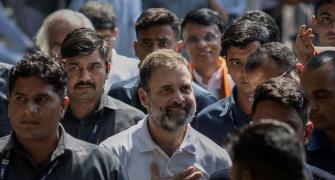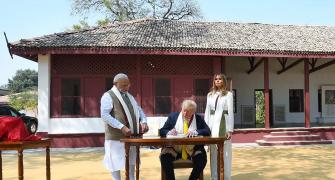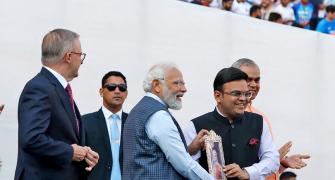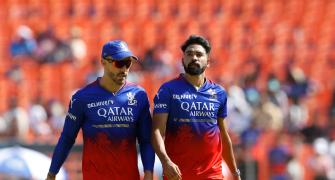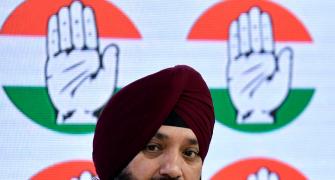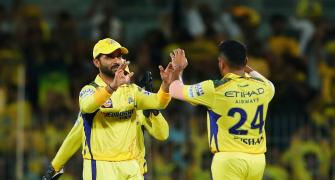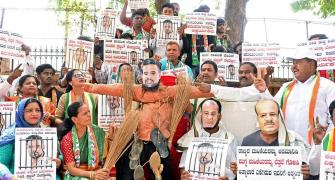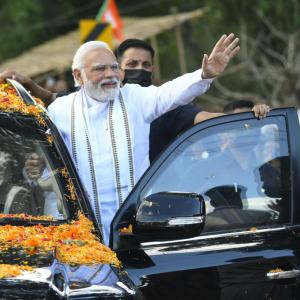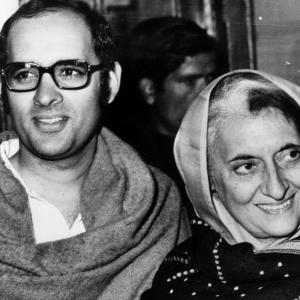The transmogrification of Prime Minister Modi to Saint Modi began with the ground-breaking ceremony of the Ram temple in Ayodhya.
By identifying himself with Lord Ram, Modi raised himself in popular imagination to a saintly person.
A fascinating excerpt from Minhaz Merchant's Modi, The Challenge of 2024.

As the 2024 Lok Sabha election nears, Narendra D Modi has emerged as the shrewdest Indian political leader since Indira Gandhi.
The two couldn't have come from more different backgrounds. Indira Gandhi was born into privilege in 1917.
Modi's circumstances -- and rise to power -- were a polar opposite. He grew up in the small Gujarat town of Vadnagar.
He left home at 17, joined the Rashtriya Swayamsevak Sangh at 19, was seconded to the Bharatiya Janata Party at 37, became general secretary looking after six states at 48, was appointed chief minister of Gujarat at 51 and -- against fierce opposition from within the party and abuse from the Congress -- won office as prime minister at 63.
While L K Advani was regarded as the BJP's hardline leader who encouraged party workers to bring down the Babri structure, Atal Bihari Vajpayee cultivated a softer image.
Yet his speech just one day before the Babri structure was demolished on 6 December 1992, laid bare his true feelings on the issue: 'Sharp and pointed stones have come out. No one can sit there. The ground has to be levelled. It has to be made fit for sitting. Arrangements for a yagya (of the Ram temple) will be done, so there will be some construction.'
Two months after the Gujarat riots, in April 2002, Vajpayee, now the prime minister, said this at a BJP national council meeting: 'We should not forget how the tragedy of Gujarat started. The subsequent developments were no doubt condemnable. But who lit the fire? How did the fire spread?'
'Wherever Muslims live, they don't like to live in co-existence with others, they don't like to mingle with others; and instead of propagating their ideas in a peaceful manner, they want to spread their faith by resorting to terror and threats. The world has become alert to this danger.'
Vajpayee was careful to cloak his thoughts in poetry, long silences and pacifist prose.
So, in Parliament in May 2002, Vajpayee declared: 'I accept the Hindutva of Swami Vivekananda but the type of Hindutva being propagated now is wrong and one should be wary of it.'
Like most Indian leaders, Vajpayee realised early in his career that you can govern a complex country like India only from the centre.
The extremes -- right and left -- aren't sustainable.
In public therefore Vajpayee drifted from the right towards the centre just as Jawaharlal Nehru, Indira Gandhi and others had drifted from the left towards the centre.

What about Modi's own ideological trajectory? Over the past nine years, Modi has evolved from a state leader to a national leader to a deified leader and finally to a world leader.
In doing so, Modi has used Vajpayee's playbook: Hard Hindutva warrior during elections; pro-poor messiah at home; and sober global statesman abroad.
Thus we see Modi's fiery version in election campaign rallies.
That is followed by a messianic touch: Providing free food and subsidies to 80 crore (800 million) distressed Indians.
And finally, a statesman-like role in global affairs as leader of the G20.
All three avatars are visible in Modi as he gears up for the 2024 Lok Sabha election. Vajpayee took the BJP from two Lok Sabha seats to 182 seats in 1998.
He became the longest-serving non-Congress prime minister in 2004.
Modi has effortlessly passed Vajpayee's record of six years as prime minister by doing exactly what Vajpayee did: Moving from the hard right towards the centre-right where governance has greater longevity.
And yet India in 2024 will not mirror the India of 1998. A new generation of voters will have come of age.
They see no contradiction between centre-right nationalism and aspirational consumerism.
As 2024 looms, Modi is attempting what no other BJP or even Congress prime minister has done: Win three consecutive Lok Sabha elections.
But didn't Nehru win three successive Lok Sabha elections? He did. In 1952, 1957 and 1962. But, of course, he didn't complete his third term.
To surpass Nehru's electoral record, Modi will have to not only win in 2024, but complete his third term in office.
Is Modi becoming another Indira? He has her political instincts. But is he now, like her, a protectionist and an enthusiastic over regulator? The short answer: possibly.
Modi's slogan 'Be vocal about local' has protectionism encoded within it.
I wrote an article in the Hindustan Times in September 2020 that the slogan should be rephrased: 'Be vocal about both local and global'.
In short, make India self-reliant but also make India an export hub and make the world India-reliant.
That is true liberalisation. It too is the orientation Modi's new forward-looking trade and economic policy is now taking.
***

The prime minister's address at the centenary of the Aligarh Muslim University in 2020 seemed to launch a kinder, softer version of Modi.
By calling Islam an integral part of India's cultural heritage, Modi went even further than Vajpayee.
According to a translation of Modi's speech as reported by a leading daily, the prime minister adopted a conciliatory tone on religious identity.
'The policies made by the government reach every section irrespective of their religion. Bank accounts of over 40 crore poor have been opened without any discrimination.
'Without discrimination, more than two crore poor were provided pucca houses.
'More than eight crore women were given gas connections without discrimination.
'Around 50 crore people got free treatment of up to '5 lakh under the Ayushman scheme without any discrimination.
'What belongs to the country belongs to every countryman and every citizen should be benefited. Our government is working with this spirit.'
'AMU's founder Sir Syed had said that growth of the country is above the caste and religion of the people. He had also given an example and said that for the body to remain healthy, every body part should be healthy.
'Sir Syed had also said that religion should not be the reason for anyone's backwardness.
'India is on the path where no citizen would be left behind because of their religion and everyone would get equal opportunities so that everyone can fulfil their dreams.'
Hardline supporters of Modi fear that Modi's 'soft secularism' is as electorally motivated as Rahul Gandhi's 'soft Hindutva'.
They believe both are ideologically corrupt.
Modi's attempt to woo Muslims, they say, is counter-productive: Muslims see through the hypocrisy of the AMU speech and anyway vote en masse against the BJP just as most Hindus see through Rahul's temple-hopping and vote against the Congress.
Modi, Muslims believe, remains an implacable Hindutva warrior. His actions, they say, belie his words.
The CAA, the revocation of J&K's special status and the building of the Ram Mandir in Ayodhya where the demolished Babri structure stood, all point in one direction: hard Hindutva.

What explains Modi's personal popularity despite the perfect storm of problems that periodically buffet India's economy and national security? A large part has to do with the psyche of the average Indian voter.
Modi's understanding of the Indian mind was acquired at an early age.
His teenage wanderings in the Himalayas, eating and living with monks, sadhus and ordinary villagers, gave him rare insights.
During a varied career in the RSS -- from doing menial jobs to fixing organisational issues -- Modi learnt much about human nature. He realised that religion played an oversized role in most Indians' lives.
Religion could have both political and psychological uses.
In Gujarat as chief minister, he employed religion to win and keep power.
But an equally powerful tool was the psychological impact of religiosity on individuals.
In no other country are religious figures treated as reverentially as they are in India.
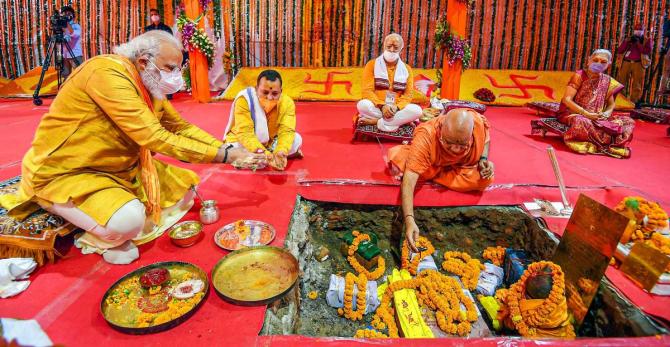
The transmogrification of Prime Minister Modi to Saint Modi began with the ground-breaking ceremony of the Ram temple in Ayodhya.
By identifying himself with Lord Ram, Modi raised himself in popular imagination to a saintly person.
The year-long untrimmed beard was symbolic: Modi was signalling penance, sharing the pain and distress of poor Indians who had lost livelihoods during the Covid pandemic.
A saint can have foibles. But most Indians think that people with Godly souls have noble intentions, irrespective of outcomes.
That is why respondents in surveys continued to back Modi despite the insensitive treatment of migrant workers during the first pandemic lockdown.
Modi cultivated an air of being a father figure. His rhetoric was softer, more persuasive than aggressive.
But Modi is not turning into a Vajpayee or a saffron version of Nehru as many of his Hindutva supporters fear.
Modi's belief in Hindutva remains as strong as ever. Only the dressing has changed.

The Congress-Left ecosystem hasn't fully understood Modi's strategy. It attacks him personally and venomously. Rahul continues to taunt him.
NGOs have sharpened their attack on him. The foreign media is irredeemably hostile. All these attacks roll off Modi's new saintly skin.
Instead of weakening his popular appeal, they appear to strengthen it.
Indians admire martyrs. That is one reason why Modi has deliberately avoided actively pursuing cases that could send the Gandhis to jail over, for instance, the alleged Rs 3,000 crore (Rs 30 billion) National Herald scam or prosecuted Robert Vadra over a decade old land corruption allegation.
The lessons of Indira Gandhi's 1980 election victory are fresh in Modi's mind.
She lost power in the 1977 general election shortly after the Emergency was revoked.
She was relentlessly attacked by the media and the Janata government between March 1977 and December 1979.
She spent hardly any time in jail. But Indians promptly voted her back to office in January 1980.
Excerpted from Modi, The Challenge of 2024, by Minhaz Merchant, Excerpted with permission from the author and publisher Amaryllis.

